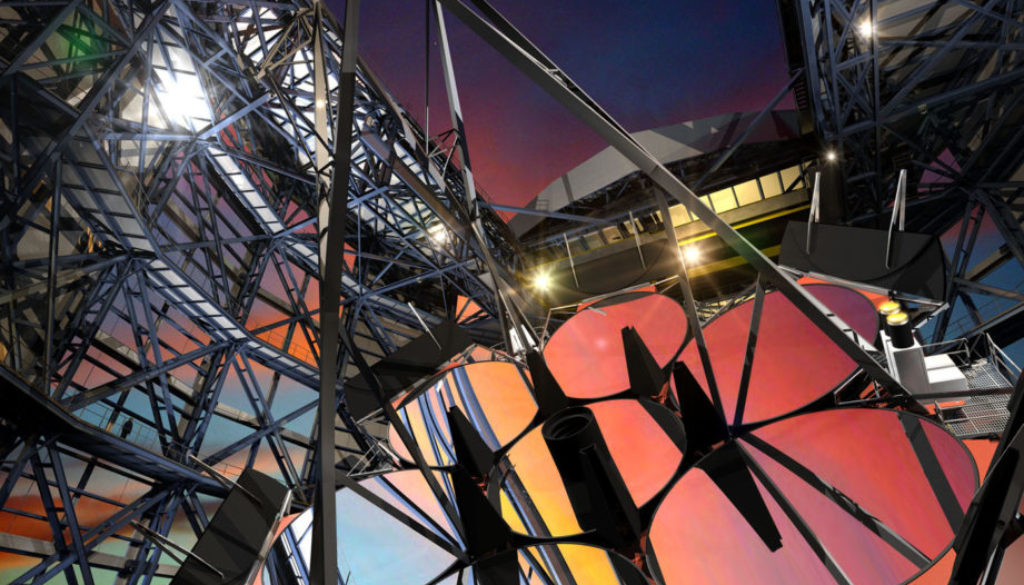Giant Magellan Telescope’s Third Mirror Unveiled
The Giant Magellan Telescope’s third primary mirror will be unveiled at the University of Arizona’s Steward Observatory Mirror Lab (SOML) on December 6, 2013. The combined surface area of the three mirrors created to date surpasses that of any existing telescope and will help enable astronomers to peer more deeply into space than ever before once the telescope is completed. Texas A&M University is a partner in the project to build the GMT, along with several other universities and institutions in the U.S. and around the world.
Primary mirrors are the heart of the modern day reflecting telescope. They capture and focus photons coming from space to help construct images of the universe and collect complex spectra. Generally, the larger the surface area of the primary mirrors, the more photons they can capture, leading to better images and improved data. The Giant Magellan Telescope will offer the best image resolution ever seen to explore deep space.
“The Giant Magellan Telescope will be one of the most powerful tools for approaching some of society’s most profound questions: where did we come from, where are we going, and are we alone in the Universe?” said Patrick McCarthy, Giant Magellan Telescope Project Director. “The technology used to design and construct the telescope is breathtaking, but the answers it may provide as to the beginnings of time itself will be staggering.”
The first of a new generation of “extremely large telescopes,” or “ELTs,” the Giant Magellan Telescope will have a mirror array consisting of seven 27-foot- (8.4-meter-) diameter mirror segments. The telescope is anticipated to begin operation in 2020 with four mirror segments completed, making it the largest telescope in the world. When its final stages of construction are complete, it will have 10 times the resolution of the Hubble Space Telescope.
Each of the Giant Magellan Telescope’s mirrors is the product of cutting edge technology and processing. Cast in a custom-built rotating furnace that reaches approximately 2,100 degrees Fahrenheit, they each weigh about 20 tons, yet their internal architecture features an intricate honeycomb pattern that allows them to regulate temperature quickly while remaining extremely rigid. Additionally, each mirror is meticulously polished and evaluated to create a surface that is so smooth that no imperfection is taller or deeper than a 20th of a wavelength of light — one millionth of an inch. (Details of the mirror-making process can be seen here.)
“The mirror surface is so smooth that if we took one 27 foot mirror and spread it out from coast to coast across the U.S., the height of the tallest mountain on that mirror would be only half an inch — an engineering masterpiece,” said Wendy Freedman, Director of the Observatories of the Carnegie Institution for Science and Chair of the Board of Directors for the Giant Magellan Telescope Organization.
The third mirror — dubbed “GMT3” — was cast in August at the Steward Observatory Mirror Lab, the only facility in the world capable of creating mirrors of this size. The University of Arizona is one of 10 international partners who are collaborating to build the Giant Magellan Telescope. Collectively, the partners represent more than 1,000 years of astronomy experience. Their accomplishments include the construction of past record-breaking telescopes and the cultivation of some of astronomy’s most brilliant minds.
“Once fully operational, this telescope will provide discoveries for the next 50 years,” added Freedman. “These huge mirrors are critical steps along the path to deployment, and then we can open the floodgates of research.”
The Giant Magellan Telescope will be constructed at the Las Campanas Observatory in the Atacama Desert in northern Chile, where it will be able to work synergistically with other astronomical instruments and surveys. The program to fund and build the Giant Magellan Telescope is a global first, targeting a total of $1 billion from mostly private, philanthropic donors, with some contributions coming from government agencies around the world.
The Giant Magellan Telescope will be the first of its kind and the largest privately led telescope initiative in history, igniting a new era of discovery and unlocking answers to some of the most fundamental questions of humanity, including whether or not life exists on other planets and how the universe began. Astronomers will also use it to better understand how planets and galaxies form and to help find answers to the mysteries of dark matter and dark energy.
For more information about the GMT, including design, scope and projected science, visit www.gmto.org.
To learn more about Texas A&M astronomy, visit http://astronomy.tamu.edu.
# # # # # # # # # #
About the Giant Magellan Telescope: The Giant Magellan Telescope Organization (GMTO) manages the GMT Project on behalf of its international partners, namely: Astronomy Australia Ltd., the Australian National University, the Carnegie Institution for Science, Harvard University, the Korea Astronomy and Space Science Institute, the Smithsonian Institution, Texas A&M University, the University of Arizona, the University of Chicago, and the University of Texas at Austin. For more information, visit www.gmto.org.
Watch an related segment from the December 7 CBS Evening News featuring GMT project director Dr. Patrick McCarthy on You Tube:
-aTm-
Contact: Shana K. Hutchins (979) 962-1237 or shutchins@science.tamu.edu or Jacqueline Efron, Zeno Group for GMTO, (650) 801-0942 or jacqueline.efron@zenogroup.com
The post Giant Magellan Telescope’s Third Mirror Unveiled appeared first on Texas A&M College of Science
